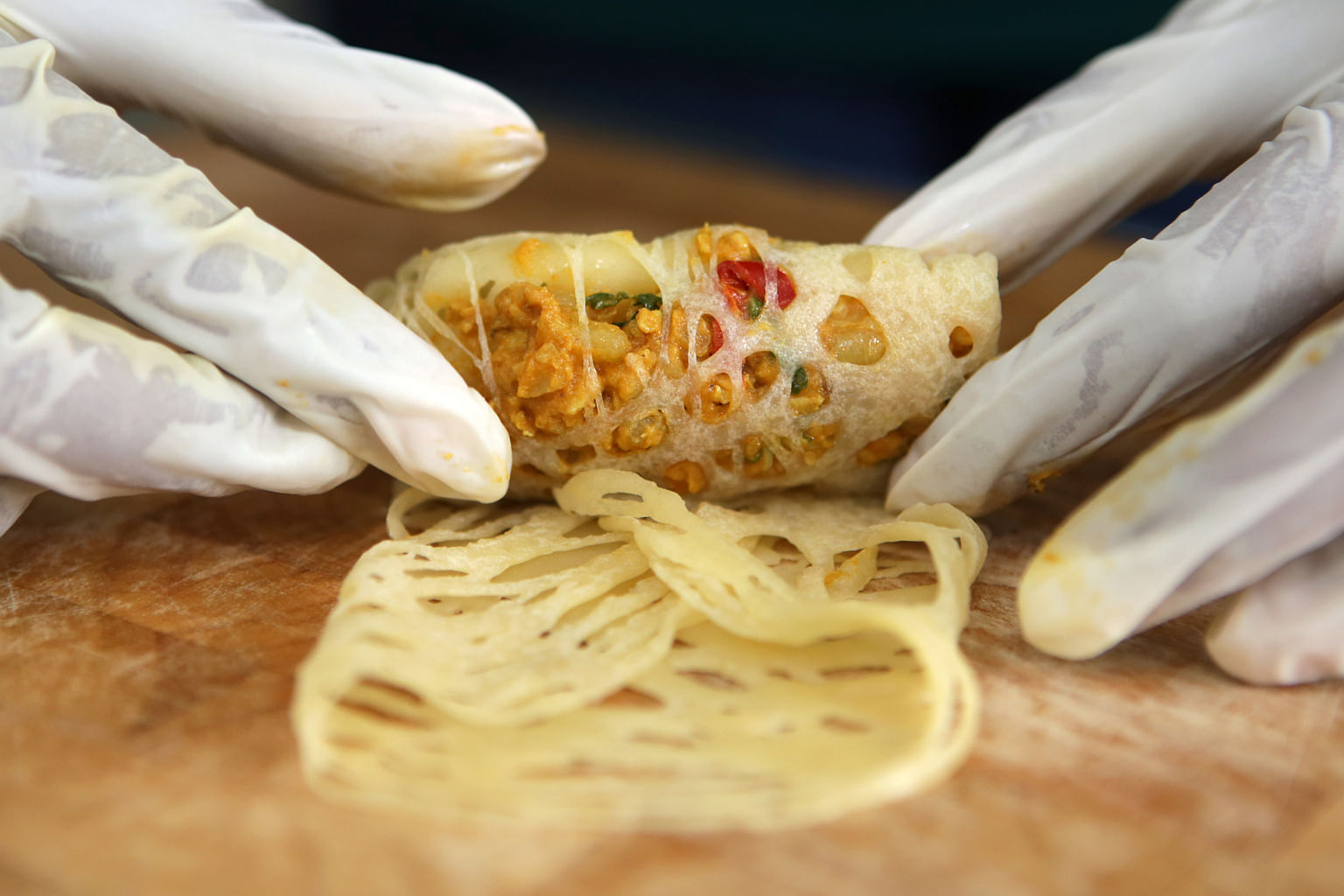Singapore Cooks
'Old-fashioned' and proud of it
Mrs Komala Selvan prefers to stick to traditional recipes and make dishes from scratch


There are gadgets and shortcuts aplenty to make cooking easier, but senior pharmacy technician Komala Selvan sticks to tradition.
She continues to use old recipes and also goes the extra mile to make things from scratch.
Instead of buying flour to make the savoury, crunchy muruku, she buys lentils in bulk, washes and dries them in the sun, takes them to a stall in Tekka Market for grinding and uses the resulting flour to make the Indian snack.
She does the same with spices to make her own blend of curry powder.
Her bandung, a drink of rose syrup and milk, is not made with store- bought cordial either. The syrup is made from fresh rose petals.
Mrs Komala, 49, picked up these traditions from her mother-in-law, Madam Meenambal, 77.
She says: "People ask me, why so old-fashioned? But then, nobody does all this now. Over time, traditions like making things from scratch will be lost."
Not only has she inherited the heirloom recipes, but she is also committed to passing them down to her daughter Pragatheeswari Senthtamilselvan, 21.
Two years ago, for her 25th wedding anniversary, Mrs Komala self- published a cookbook of 25 family recipes. The book is not for sale and was given to just family and friends. Recipes include prawn masala, chicken murtabak and biryani.
Mrs Komala says: "It's important to pass recipes on to the next generation. If not, this tradition will be lost."
She shares her recipe for roti jala - translated to "net bread" in Malay and often called lacy or netted crepes - which is from her mother-in-law.
Unlike other recipes, which call for the filling and crepes to be served separately, her roti jala is stuffed with a dry chicken and potato curry. It can also be eaten with mutton or vegetable curry.
There is no need to flip the crepes, as the heat from the flat pan will cook the thin batter.
"If the roti jala is overcooked, it will be too crispy and will crack when it is filled and rolled."
She uses a traditional brass roti jala mould, handed down by her mother-in-law, to make the thin pancakes. It works much better than the plastic bottle she bought for convenience.
"I thought getting the plastic one would be better. But the batter doesn't flow through properly, so the traditional one still works best."
Ms Pragatheeswari, a final-year accountancy undergraduate at the Singapore Institute of Management, is her handy kitchen assistant. She makes the roti jala with ease and fills it with precision.
The budding cook started helping her mother in the kitchen five years ago.
Mother and daughter work in harmony in the kitchen and, when that is pointed out, they laugh heartily and immediately say that they have their fair share of kitchen squabbles.
"It can be chaotic when my mum tells me how and what to do. So we each have a role - everyone helps," says Ms Pragatheeswari, who is an avid baker.
Mrs Komala picked up cooking after she married her husband, Mr Senthtamilselvan, 55, a senior aircraft engineer.
She attended classes at community centres and went to cooking demonstrations by chefs. Some of her best dishes include mee rebus, lontong, mee siam as well as muruku - also cranked out using a traditional mould.
While she has honed her skills in the kitchen over the years, Mrs Komala's job of packing medicine for patients has also helped make her a better cook.
She says: "You have to be precise in the amounts you pack. That attention to detail has helped to improve my culinary skills.
"Maybe for my 50th wedding anniversary, I'll do a cookbook with 50 recipes."
MAKE IT YOURSELF: ROTI JALA
INGREDIENTS
For the filling:
4 Tbs oil
1 tsp fennel seeds, lightly pounded in a mortar and pestle
6 cloves garlic, pounded to a paste
100g shallots, finely chopped
1/2 tsp salt
1/2 tsp sugar
230g minced chicken
50g green peas
2 tsp meat curry powder (Baba's brand from supermarkets)
1 1/2 tsp chilli powder
1/2 tsp turmeric powder
150ml coconut milk
2 potatoes, skin removed, diced and cooked until soft
Leaves from five stalks of coriander, finely chopped
1 sprig curry leaves

For the roti jala:
200g plain flour
1/2 tsp salt
450ml water
A pinch of orange colouring powder or one drop of liquid orange colouring
3 Tbs melted ghee, for greasing the pan
METHOD
1. Make the filling: Heat the oil in a frying pan. Lightly fry the fennel seeds until fragrant. Add garlic, shallots, salt and sugar.
2. Stir in the chicken, peas, curry powder, chilli powder and turmeric powder. Pour in the coconut milk and cook for about five minutes or until the meat is tender.
3. Add the potatoes, coriander and curry leaves. Mix the ingredients and you should get a dry curry. Scoop into a bowl and leave to cool.
4. Make the roti jala: Place flour, salt, water and colouring in a blender and blend to get a smooth mixture with no lumps. You can also use an electric mixer. Sieve the batter to remove any lumps.
5. Place a flat non-stick pan over medium heat. Brush it with ghee. Using a ladle, scoop the batter into the roti jala mould. As the batter flows through the holes, make circular motions over the pan to form a net pattern. Place a bowl or cup under the mould to avoid spilling the batter on the stove.
6. After about one minute, the top of the crepe will set. Carefully lift the crepe with a spatula and transfer to a plate to cool. Do not leave the crepe to cook for too long, as it will become crispy and crack.
7. Repeat and use up the rest of the batter.

8. Place one roti jala on a plate. Spoon 1 Tbs of the potato filling onto the bottom of the roti jala. Gently fold in the two sides of the crepe towards the middle and roll it up tightly like you would a spring roll. Repeat for the rest of the crepes and filling.
Makes about 30 roti jala
Join ST's Telegram channel and get the latest breaking news delivered to you.
A version of this article appeared in the print edition of The Sunday Times on October 30, 2016, with the headline 'Old-fashioned' and proud of it. Subscribe

